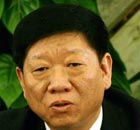4,000 reasons for change
Updated: 2010-03-08 07:47
By Zhang Monan (China Daily)
As China's per capita GDP gets closer to $4,000, a critical period for development emerges
China's gross domestic product (GDP) amounted to 33.54 trillion yuan last year, with a per capita GDP approaching $4,000, according to recent data from the National Bureau of Statistics.
The per capita figure represents a critical point for the transformation of the country's economic and social development from a mode of survival to growth. Similarly, the country's economic model is also expected to value growth in quality more than in quantity.
| ||||
Per capita GDP of $4,000 indicates that China will be in position to transform its previous economic growth structure. Some Western economic theorists, such as American economists Hollis B. Chenery and Walt Rostow, have contributed to the notion that China's economic structure is now at a critical juncture. The $4,000 level means that technological innovations will replace investment to become the country's biggest driving force. But some new changes are also expected to emerge in industries.
A theory of economics by Briton Colin G. Clark in 1941 as well as other economic theories believe that the rise of a country's per capita income will help its economic focus shift from the primary sector to the secondary and tertiary sectors. It goes on to state that the tertiary sector will become the dominant status in the country's economic development. Prior to the era of the per capita $4,000 GDP, all developed countries were basically at an industrialized stage, in which their economic boom mainly depended on investment and the progress of industrialization. However, in the post-$4,000 era, consumption and the service industry became new growth areas instead of investment. In the process, the proportion of the tertiary sector in the economic landscape gradually grew to more than 60 percent, and industrialization tended to become more sophisticated.
Concurring with these changes is the expected change in China's labor and employment sector. Experiences in developed countries indicate that after achieving a per capita $4,000 GDP, a so-called "Lewis Turning Point" will likely emerge as huge changes take place to its population and employment. The country will likely enter a cyclical period in which costs for its essential factors of production will spiral. At this stage, developed countries adopted available measures to improve population quality and human resource fields. A huge structural adjustment took place. Some profound changes emerged in such areas as division of labor, industries and employment, as well as to fields of deposit, consumption, investment and social security.
At the $4,000 level, China's national wealth distribution is expected to experience change. The country's middle class will rapidly expand and gradually become a solid driving force for its economic development. In developed countries, such as the US, Japan and nations in Europe, middle-class families account for more than 30 percent of their respective populations and make up the lion's share of consumers due to their increased purchasing power. The formation of a middle class prone to consumption will also help push a transformation of China's society and contribute much to its social stability. Experiences in developed countries also prove that a booming middle class played a big role in propping up their sustainable economic development and pushing per capita GDP value forward.
A country's economic development is mostly decided by its ability to accumulate domestic capital and its efficiency in using resources. Excessive dependency on foreign capitals to fuel industrialization will not last. Thus, a country will inevitably face the choice of expanding its outward investment as the means to sustain its economic growth when its economy reaches a certain development level. The country should try to improve returns of its outward investment and sharpen the edge of its capitals in increasingly fiercer international capital markets. Japan did very well in this aspect. Due to its active efforts to promote its transformation from product exports to capital exports in the 1980s, the country's economic development rapidly entered a new stage.
The global financial crisis has offered China rare chances to profoundly reflect on deep-rooted problems to its economic development. The country's traditional economic growth model is now under severe pressure and long-held factors that have bolstered rapid economic development, such as a cheap labor force and globalization, are on the wane. The decades-long model that mainly depends on cheap exports and large-scale investment has come to an end.
Despite the impact of the global financial crisis, last year still marked a new point for the growth of China's national wealth. But whether the country can successfully revamp its thorny labor, demand and industrial structures and then avoid the so-called "middle income trap" will decide whether the nation can leap farther in its economic development in years ahead.
The author is an economics researcher with the State Information Center.
(China Daily 03/08/2010 page8)
Paper's Digest

Chinese jet takes on Big 2
First large commercial plane set to ride on demand for aircraft as economy grows.
Super-CPU only for domestic eyes
Specials

Gaining ground
Doing business in china for westerners has come a long way, Peter batey says.

Safeguarding environment a priority
China continues to face mounting pressure to curb environmental degradation, despite progress in reducing pollution over the last five years, the environmental protection minister warned.

Employment to remain a continuing challenge
China's top labor official said the country will face a tough employment situation in the next five years.




